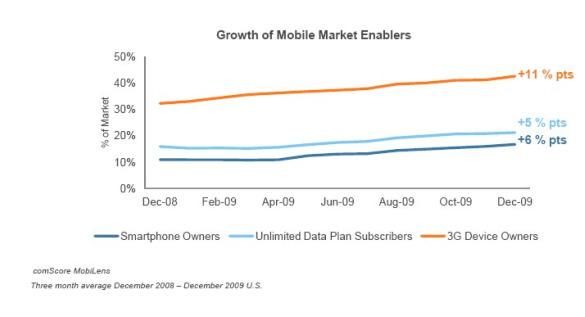I’ve written many times about mobile marketing, and even (along with others, I’m sure) predicted foursquare-type business marketing many years ago. Does anyone remember my “senseweb” idea? Probably not, it was pretty far out at the time…
But in the past two years, having met with many clients and associates, I realize that almost none of these companies are paying attention to mobile marketing. One company I talked to in Feburary had spent $40k on their new site and ecommerce engine, but not a dime of that went towards presenting well on mobile interfaces. Apparently, near the end of the project, someone pulled the site up on an iPhone and proclaimed that they looked fine in mobile browsers (they didn’t, but that’s not worth exploring here.) Perhaps this is an unusual case, or not.. The data I’ve seen show that mobile web marketing spends are climbing by nearly 30% per year. Promising. But if you look at it in the grand scheme of the bigger marketing budgets, it’s still a tiny sliver. This year, Amazon reports that it made $1B (with a “B”) from mobile alone in the past 12 months!
What disturbs me most is the lack of consideration for the mobile users’ evolving sophistication and habits (29% of all cell phones will be smart phones by 2014) The fact that they are not sitting at a calm desk looking at a 24″ monitor, but on the go – possibly sitting in a parked car or looking at a building site.
The idea that you’d just “throw” your regular website into Safari on an iPhone and consider the issue solved is short-sighted. I also sense that there is an assumption that, because past mobile surfing experiences were awkward, the platform simply isn’t worth serious attention. But things have changed a lot…designers are adopting better usability into mobile sites as they mature in the space and user experiences are improving all the time. Using a mobile phone on the web is becoming more of a pleasure with less compromise. Mobile search is leading the way with huge  investments by Google and Bing, partially due to threats posed by sites such as Facebook.
investments by Google and Bing, partially due to threats posed by sites such as Facebook.
The image that comes to my mind these days is a big freight train. You can hear it over the horizon right now. The tracks are rattling and animals have hidden themselves and the signal crossings are binging away. But few are paying attention. In some cases, the mobile platform is the most important one! If you run a gym or restaurant, you are already woven into the movement of your customers’ day – you’re just as likely to be visited via the phone as via a computer.
Between December 2008 and December 2009, the percentage of US mobile phone subscribers with unlimited data plans increased from 16% to 21%, with several phones now requiring an unlimited data plan subscription at the time of purchase. During the same period, smartphone ownership increased from 11% to 17%, while 3G phone ownership increased from 32% to 43%. – Comscore
Mobile developers have a golden age just starting. Building mobile sites and applications specific to certain companies will blow up the way that custom website creation did in 2002-2003. Generic, templated sites will have to do for most, and that’s better than nothing – but if you really want to project your brand, you’ll need to be more clever. Study the patterns until you see that to succeed, the mobile site must be a custom, mobile-centric experience. Not a micro-rendered version of your current site.
Mobile web marketing strategy thoughts from the field
- Consider the mobile scenarios for your customers.
- Look at your existing analytics – Multiply that number by four for next year’s estimate.
- Have any of your customers said something about accessing your site on mobile?
- Does your business attend a lot of conferences? Consider making a mobile device tuned for this.
- Start simply. Create a mobile site for the executives to use first, then show it to key customers.
- Don’t ignore the possibility of making a mobile intranet for your field staff as a first project.
- Think about how you will integrate your mobile site into search engines, maps, social media.
- Often, entire mobile development programs can be funded by just removing unused parts of a corporate site.
- If you are not surfing the web yourself via mobile, start now. Otherwise you make too many assumptions.
- Get your team some of the most popular phones out there, even without phone plans (most use wifi) . Make them a fixture in the center of the conference table during website meetings.
- During your next meeting..spend 10 minutes asking your customers what they think about your mobile site. People love showing off their toys in meetings.
- Don’t get stuck in the iPhone hype… a huge quantity of Android apps are looming as developers switch to the platform in droves.
- Prioritize around analytics and company strategy.
Often all it takes is to bring the topic up and go round the table to understand where people stand on this issue. Send some key employees to a mobile conference. We all know that marketing and PR departments are stretched thin, and that sometimes bringing up new topics like this isn’t that popular. From what I can see, however, we have the means to accomplish a lot, but prioritization based on good data are needed.
Freight Train Photo: Hunter Desportes on flickr used under CC attribution license








